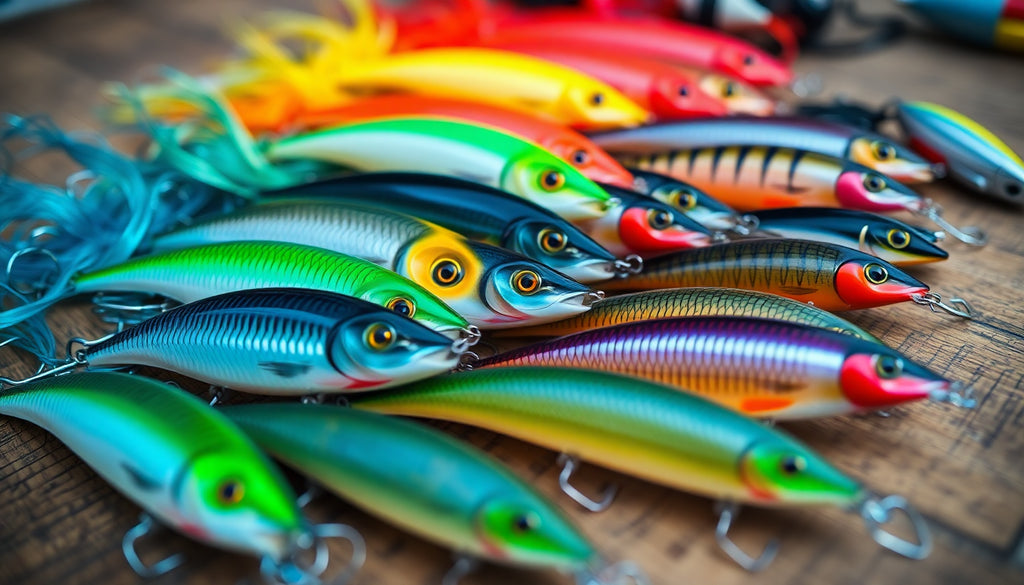A Guide to Different Types of Saltwater Fishing Lures
Posted by KNOTTYTAILS

A Guide to Different Types of Saltwater Fishing Lures
Fishing is not just a hobby; it's a passion for many. When it comes to saltwater fishing, having the right tools can make all the difference. Among these tools, fishing lures play a vital role in attracting fish. Understanding the various types of lures and their uses can significantly enhance your fishing experience. In this guide, we’ll explore the best fishing lures for saltwater, helping you choose the right lure for your next adventure on the water.
What Are Fishing Lures?
Fishing lures are artificial baits designed to attract fish. They come in various shapes, sizes, colors, and materials, each serving a unique purpose. Lures mimic the movement of prey to entice fish into striking, making them effective tools for anglers. The diversity of fishing lures allows you to target specific species and adapt to different fishing conditions.
Top Saltwater Lures
When it comes to saltwater fishing, certain lures stand out for their effectiveness. Here are some of the top saltwater lures you should consider:
Jigs
Jigs are popular for their versatility in saltwater fishing. These lures consist of a weighted head and a hook, often adorned with soft plastic tails. They can be used for various techniques, such as vertical jigging or casting.
Popular Jig Types
Different types of jigs work for different fish. For example, heavy jigs work well for deep-sea species like grouper, while lighter jigs are effective for surface-feeding fish like snapper. The adaptability of jigs makes them a must-have in any saltwater angler's tackle box.
Soft Plastics
Soft plastic lures are a favorite among many anglers due to their realistic action. These lures come in many shapes, including worms, lizards, and shrimp, making them versatile for various species.
Tips on Rigging Soft Plastics
To use soft plastics effectively, rig them on a hook that matches their size. Texas rigging is a popular method for minimizing snagging, while drop-shot rigs can keep the lure suspended where fish are feeding. The key is to experiment with different presentations until you find what works.
Spoon Lures
Spoon lures are metal lures known for their unique fluttering action. When retrieved, they mimic wounded baitfish, making them appealing to predator fish.
Best Practices for Retrieved Spoon Lures
To retrieve spoon lures effectively, use a steady and consistent motion. Varying the speed can also trigger a predatory response from fish. These lures shine in both shallow and deep water, especially where schools of baitfish are present.
Topwater Lures
Topwater lures provide an exciting fishing experience as they create commotion on the water’s surface. Their splashy action draws fish to strike from below.
Ideal Conditions for Topwater Lures
Topwater lures are best used in low-light conditions or when fish are actively feeding on the surface. Early mornings and late evenings are prime times to use these lures for species like tarpon and striped bass.
Swimbaits
Swimbaits are designed to imitate the swimming motion of baitfish. They are often larger lures meant for bigger game fish.
Fish Species and Swimbaits
Many saltwater species, including redfish and flounder, respond well to swimbaits. They can be fished in various depths and retrieved at different speeds to match the fish’s activity level.
How to Choose Fishing Lures
Choosing the right fishing lure can be overwhelming with so many options available. Here are some tips to guide you:
Matching Lures to Fish Species
Understanding the species you are targeting is crucial. Some lures are specifically designed for certain fish, enhancing your chances of a catch.
Examples for Common Fish
For instance, paddle tail swimbaits are effective for bass, while jigs work wonders for flounder. Research the best fishing lures for saltwater species in your region to increase your success rate.
Considering Water Conditions
Water conditions play a significant role in lure selection. Clarity, temperature, and current all affect how fish respond to lures.
Adapting to Tidal Movements
When fishing in tidal waters, it’s essential to adapt your lure choice. During high tide, fish tend to be more aggressive, allowing for topwater lures to shine. In contrast, low tide may require slower-moving lures like jigs.
Seasonal Factors
Seasonal changes influence fish behavior and their feeding patterns. Knowing how to adjust your lure selection with the seasons can improve your results.
Adjusting Lure Selection
In spring, fish often feed aggressively as they move to spawn, making brighter lures effective. In winter, consider using more natural colors to match baitfish.
Best Colors for Saltwater Lures
Color can make a significant difference in the effectiveness of your lures.
Visibility in Different Water Conditions
The color of your lure can affect its visibility. Bright colors can stand out in murky waters, while more natural colors work better in clear conditions.
Colors for Murky vs. Clear Water
In murky water, consider using fluorescent colors like chartreuse or orange. In clear water, natural shades like blue or green can mimic actual baitfish.
Seasonal Color Changes
Colors can also vary in effectiveness depending on the season. During the warmer months, baitfish often have bright, vibrant colors, while in cooler months, more subdued, darker shades are more suitable.
Matching Lure Colors to Baitfish
Observing the local baitfish can guide you in selecting the right lure color. If you notice silvery baitfish, silver or white lures can be effective.
Tips for Using Lures Effectively
To maximize your fishing success, consider the following tips:
Techniques for Casting
Effective casting is crucial when using lures. Learning the best methods for each lure type can improve your fishing experience.
Tips on Distance and Accuracy
Practice your casting to enhance distance and accuracy. Target specific areas where fish are likely to be, such as structures or underwater formations.
Retrieving Strategies
Varying your retrieval technique can be key to enticing a strike from fish. Slower retrieves often work for some species, while others might prefer faster action.
Experimenting with Lure Placement
The depth and location of your lure can greatly affect your success. Experiment with different placements until you find where fish are feeding.
Conclusion
Choosing the best fishing lures for saltwater fishing can enhance your experience on the water. From jigs to swimbaits, understanding the nuances of each lure type is essential. Take the time to experiment with different lures, colors, and techniques, and you'll soon find yourself catching more fish. Happy fishing and tight lines!

